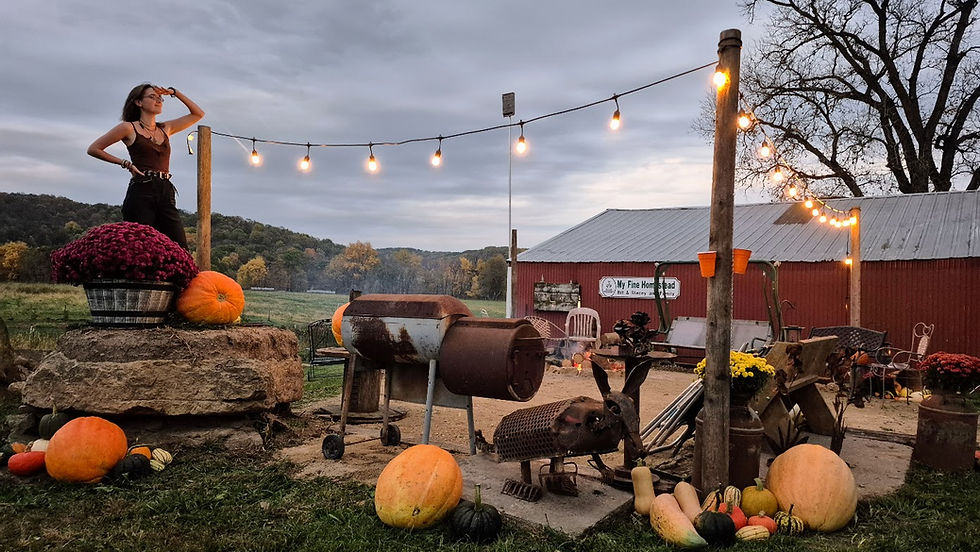Sap is Starting to Run!
- Stacey Feiner
- Mar 3, 2016
- 3 min read
On the Farm . . . what's happening this week - March 3, 2016.
Here we go – it’s time for maple sugaring season!!! The season is earlier than the last couple but well within the normal time frame as the sap usually flows for a couple of weeks in February and March.
Despite fighting the flu last week, Bill along with his trusty sidekicks, Aidan and Liam, have our taps, lines and totes out in the sugar bush at his dad’s farm, 6 miles north of our place. This year Aidan tasted sap from almost every tree to “check for quality.” Liam feels his brother slowed the job down to be annoying in the way only a younger brother can.
Did you know that Native Americans were harvesting sap before the Europeans came to North America? As homesteaders, Bill and I have a love for processes that hark back in history even while we tweak them with modern machinery like a drill, a four-wheeler, and an evaporator. It makes us feel connected to those who came before while being firmly anchored in the here and now.
Have you wondered what causes the sap to flow? It is an interesting and rather complicated process involving temperature fluctuations, pressure, and suction in the tree. Here’s an explanation from Cornell University: Early in the spring, when the maple trees are still dormant, temperatures rise above freezing during the day but drop back below freezing at night. This fluctuation in air temperature is vital to the flow of sap in sugar maple trees.
What causes the sap of maple trees to flow in the spring? During warm periods when temperatures rise above freezing, pressure (also called positive pressure) develops in the tree. This pressure causes the sap to flow out of the tree through a wound or tap hole. During cooler periods when temperatures fall below freezing, suction (also called negative pressure) develops, drawing water into the tree through the roots. This replenishes the sap in the tree, allowing it to flow again during the next warm period. Although sap generally flows during the day when temperatures are warm, it has been known to flow at night if temperatures remain above freezing.
Thus, pressure and suction are essential to sap flow. But how do the pressure and suction develop? Sap flows through a portion of the outer tree trunk called sapwood. Sapwood consists of actively growing cells that conduct water and nutrients (sap) from the roots to the branches of the tree. During the day, activity in the cells of sapwood produces carbon dioxide. This carbon dioxide is released to the intercellular spaces in the sapwood. In addition, carbon dioxide in sap is released into the spaces between the cells. Both of these sources of carbon dioxide cause pressure to build up in the cells. A third source of pressure is called osmotic pressure, which is caused by the presence of sugar and other substances dissolved in the sap. When the tree is wounded, as when it is tapped by a maple producer, the pressure forces the sap out of the tree.
At night or during other times when temperatures go below freezing, the carbon dioxide cools and therefore contracts. Some of the carbon dioxide also becomes dissolved in the cooled sap. Finally, some of the sap freezes. All three of these factors create suction in the tree. This causes water from the soil to be drawn up into the roots and travel up through the sapwood. When temperatures rise above freezing the next day, sap flow begins again.
Thus, the cycle of warm and cool periods is essential for sap flow. Temperatures too warm or too cool during the short, six-week "sap season" will reduce the amount of sap flow. This will result in lower maple syrup production or a "bad year" for maple producers in the region.
It takes between 40 and 80 gallons of sap to make 1 gallon of syrup. The difference depends upon the amount of sugar in the sap when it is collected, the average amount being 2% sugar. Typically sap collected the first days contains a higher than average percentage while subsequent days contain less. The sugar in the sap is converted from carbohydrates the tree created through photosynthesis the previous summer.
We welcome this season as we ran out of syrup about 3 weeks ago and are eagerly waiting to enjoy some fresh from the evaporator. So here’s to a maple season of high sugar sap, not getting the four-wheeler stuck in thawing dirt mixed with melting snow, and sunny, warm days coupled with and crisp, cold nights!












Comments